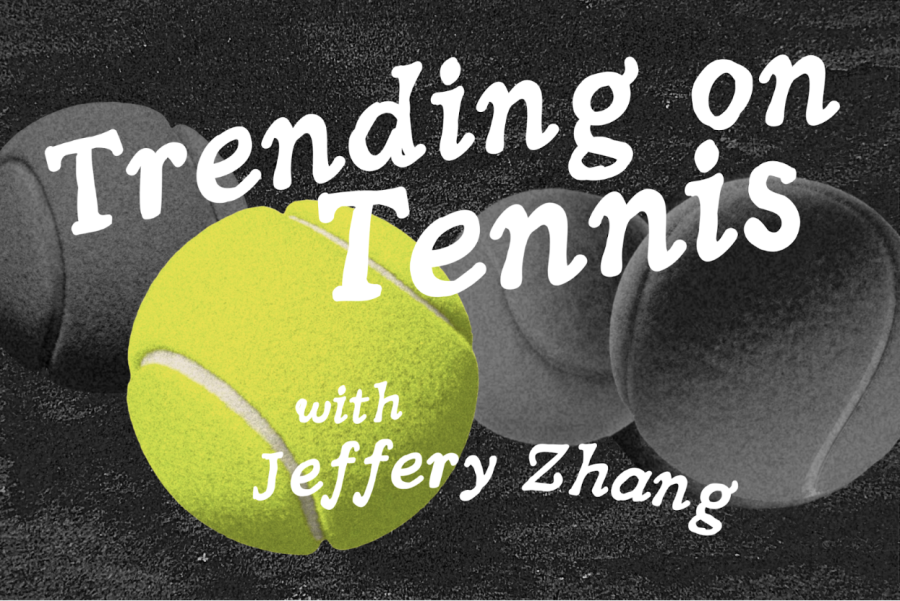Trending on Tennis: USTA’s new rating system is horrible
Credit: Alyssa Ao
WSPN’s Jeffery Zhang reflects on Daniil Medvedev’s losses at the French Open.
March 7, 2023
The Untied States Tennis Association (USTA) is the national governing body for the sport of tennis. Since 1881, they’ve provided thousands of tournaments per year for American junior tennis players, and have given players opportunities to improve and be seen by colleges and universities for recruitment. However, their decision to create their own rating system is not a decision I can get behind.
Although the USTA may be the leading tournament provider in the U.S., colleges and universities don’t necessarily focus on USTA rankings. Universal Tennis Ratings (UTR), is the index that college tennis coaches use to determine whether a prospective recruit fits their team’s competitive level. A player could increase their UTR by doing well in either a tournament held by USTA, or a tournament held by UTR. This symbiotic relationship between USTA and UTR allows players more tournament opportunities, and in turn, a higher desire to compete and increase one’s UTR. But, nothing good lasts forever. The USTA created their own rating system, the ITF World Tennis Number, in an attempt to compete with UTR, and it’s horrible.
Why is the ITF World Tennis Number so bad? To start, nobody knows if it works properly. The organization behind UTR developed and tested their algorithms before launching it to the public. USTA, on the other hand, did not test their algorithm before launching the ITF World Tennis Number, so how do we know if it works? We don’t. Junior tennis players in the United States now have to blindly follow this rating system without a clue if it truly works or not.
In addition, USTA’s explanation of how their algorithm works is incredibly vague and brief compared to UTR’s explanation of their algorithm. While UTR has an entire page dedicated to the breakdown of their algorithm and how a player can increase their rating, USTA has their explanation as a short answer in an FAQ section. But more importantly, the USTA’s explanation is not clear to tennis players on how to increase their ITF number. The FAQ answer doesn’t mention specifically what factors can change a player’s rating and how.
“Your ITF World Tennis Number changes depending on your match score and how it compares to the projection,” the FAQ answer on the USTA site said.
Well, what does that mean? Does that mean that if a player wins more games than projected, their rating will go up? What if a player wins, but the match is closer than projected. Does the player lose rating? Or what if a player loses, but they won more games than expected. Does that also affect their ITF World Tennis Number? There are so many questions left unanswered by this new rating system.
I honestly think it’s incredible how an organization as big as USTA can release a brand new rating system and proceed to explain their algorithm in just one paragraph. But what’s most important isn’t the fact that USTA didn’t test their algorithm or that their explanation is poor, it’s that the Intercollegiate Tennis Association (ITA), the governing body and coaches association for college tennis, appointed the USTA’s rating system as the exclusive official rating of the ITA and college tennis.
By colleges officially adopting USTA’s new rating system, it renders UTR useless for junior players seeking college recruitment. Unless you want to play just for fun, there is no point in playing UTR tournaments, as they don’t count toward your ITF World Tennis Number.
That’s another difference between USTA and UTR. Since UTR’s creation, the system allowed tournaments hosted by USTA to also count toward one’s UTR rating, and this positively impacts a player’s rating simply because more tournaments count towards the rating. Meanwhile, USTA restricts their rating system to only change based off of their own, USTA-run tournaments. It’s almost as if the USTA is trying to stomp out UTR.
USTA’s quest to create a rating system was only to try and compete with UTR. USTA never cared about how UTR was allowing more opportunities to play and compete to young players, and they never cared about how UTR was increasing the spread of tennis in America.
USTA only paid attention to how UTR was growing larger and as a response, created their own rating system in an attempt to remain relevant as UTR grew in junior, collegiate and professional tennis. However, in doing so, they destroyed UTR and, as a result, destroyed the countless playing opportunities for young junior tennis players in the United States.





![Last Wednesday, the Wayland School Committee gathered to discuss a number of topics regarding the health curriculum and Innovation Career Pathway course. Another large topic of conversation was the ways to potentially mitigate distracting cell phone usage. "These [phones] are going to distract your learning and social relationships," Superintendent David Fleishman said. "That's concrete right there."](https://waylandstudentpress.com/wp-content/uploads/2025/06/Screenshot-2025-06-04-at-9.49.31 PM-1200x886.png)



























![Troy Hoyt finishes the Boston Marathon, running for the Hoyt Foundation. T. Hoyt is the son of Hoyt Foundation CEO Russ Hoyt.
“[Running a marathon] might seem like a big thing, when it’s presented to you at first, but if you break it up and just keep telling yourself, “Yes, you can,” you can start chipping away at it. And before you know it, you’ll be running the whole 26 miles, and you won’t even think twice about it.” T. Hoyt said.](https://waylandstudentpress.com/wp-content/uploads/2025/04/C36E8761-1CBB-452E-9DF2-543EF7B1095E_1_105_c.jpeg)














































Rich Neher • May 30, 2023 at 3:21 PM
Jeffery, I applaud your ability to look through smokescreens and other ways of the USTA of pulling the wool over our eyes. Every month I’m writing about the poor USTA decision to sink millions of dollars into a new rating system while we have two well-functioning systems, UTR and NTRP in my newsletter Tennis Club Business. I’m saying USTA decision because the people that moved the project forward were USTA folks, Dave Haggerty and Katrina Adams. And they gave it (and more) to a UK company that had never done a project of that magnitude, ClubSpark. The USTA for decades is plagued by poor leadership that have put the organization into debt to the tune of $726M. And by a do-nothing good old boys Board of Directors whose only concern seems to be the free tickets to every Grand Slam’s President’s Box.
Well done, Jeffery.
Tia • May 22, 2023 at 12:30 AM
Really great article. This sums up my thoughts and then some!
Juan Carlos Pacheco • Mar 13, 2023 at 11:28 AM
Excellent points. Another example of how tennis, both pro and amateur, is a selfish money grab by a bunch of acronymic organizations that are corporations viewed as community service “Non-Profits.” You eloquently and with detail, outline the travesty that is the laughable USTA system. It’s obvious to everyone that it’s bad for American tennis and good for no one. I play ITF Master tournaments all around the world and the ITF number is ignored by everyone. People ONLY care about and utilize UTR. Great writing and analysis. Thank you. A follow up a 6 months or a year in that tracks the debacle would be interesting.